FESTIVALPROGRAM BLOG
EXCERPTS IN GERMANSIMPLICITY - the art of complexity - ARS ELECTRONICA 2006 - Festival für Kunst, Technologie und Gesellschaft - Linz, Do 31. August – Di 5. September
19
Jun
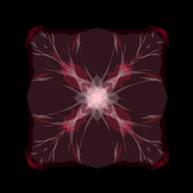 © Meeri Mäkäräinen
© Meeri Mäkäräinen
Ruby is a computer program that produces an animation of a gemstone brought to life. The program performs a physical simulation of two elastic membranes vibrating in an environment where the laws of physics have been modified. In a perfect physical simulation vibrating membranes would gradually lose their kinetic energy due to resistant forces. In this simulation, however, membranes gain energy from vibration instead of consuming it. The extra energy is a source of complex emergent behaviour of the membranes - the membranes make movements that could not have been predicted.
The simulation is visualised with an animation in which two translucent square shaped membranes vibrate together. The membranes are rendered with polygons, which is why we see angular forms.
The angular look of the polygons combines with the organic nature of the elastic membranes to create a continuous metamorphosis between a faceted gemstone and a flourishing flower.
Ruby: Meeri Mäkäräinen
18
Jun
Kristian Simolin – Visual Artist and 3D-animator based in Helsinki. Explores 3D character animation as a medium for artistic expression. Works range from interacticve installations to web based real-time projects.
Pauli Laine – Musicologist, PhD, composer. Investigates music through cognitively inspired algorithmic generative methods which can also be used as a tool in composition. Pauli has worked in several research positions in academia and industry.
Kristian Simolin & Pauli Laine: Joutokäynti – Idle Running
18
Jun
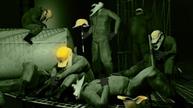 © Kristian Simolin
© Kristian Simolin
Joutokäynti – Idle Running is an animated media art work by Kristian Simolin and Pauli Laine.
The centre stage is given to a group of workmen, who have been placed in simplified, industrial surroudings. Each of the workmen repeat their individual, restless and inward movement, which changes only a little when repeated. The rhythm and the repeated movements of the characters together with the soundtrack form a hypnotic rhythm. In the animation, the world is formed of a little, standing-still moment that continues forever. The characters are in constant move, but the movement does not have a goal.
The starting point of Idle Running's animated movements are those small repetitive motions people make when they are nervous or frustrated: the rhythmic tapping of the foot or the hand, or the fiddling about with an object or a garment. Tiny movements like these form a restless world of motions characteristic of queues, public transport, and waiting rooms. The psychological meaning of the small, recurring movements is adaptation to oppressing surroundings and situations.
Joutokäynti – Idle Running: Kristian Simolin and Pauli Laine
17
Jun
Markku Nousiainen (b.1970) is a concept designer and media artist. He has study backgrounds in digital media and engineering, and is especially interested in using audiovisual media in connection with performing arts.
Markku Nousiainen and workgroup: UMBRA – Creating Theatrical Illusions with Digital Media
17
Jun
Campus | posted by Gerda Hinterreiter | at 09:15:00
UMBRA – Creating Theatrical Illusions with Digital Media
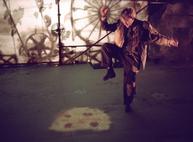 © Markku Nousiainen
© Markku Nousiainen
Umbra is a dance performance where live performers meet a virtual world created with the aid of digital media. It’s a fantasy tale inspired by old innovations and the aesthetics of magic lanterns and early cinema.
The story of Umbra is about an innovator who tries to accomplish a perpetual motion machine with the aid of his dance movements. He is assisted by a robot servant (actually, a small remote-controlled robot prototype). One day, the innovator is confronted by a stranger who enters his lab.
The style of the performance is determined by monochromatic silhouette animations, worn-out costumes and futuristic but rusty technology.
My motivation for the project was to experiment with different elements in storytelling: live dancers, virtual characters and virtual scenography, and a mechanical robot, to see how they can be combined. I wanted to create a performance reminiscent of the pre-cinema magic, but with today’s digital tools. The resulting performance is both highly technological and old-fashioned, in the sense that the projections have a role similar to that of traditional theatrical illusions.
Umbra is exhibited as a video installation.
Umbra: Markku Nousiainen and workgroup
16
Jun
Kati Åberg (Finland) is a media artist and producer who is interested in interdisciplinary art forms and in combining performing arts with new media. She has graduated from the Media Lab Helsinki and the Theatre Academy of Finland.
Kati Åberg: Emotions in Man
16
Jun
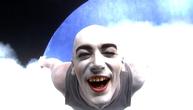 © In image: choreographer Jyrki Karttunen
© In image: choreographer Jyrki Karttunen
Emotions in Man is a interactive contemporary dance dvd. The piece investigates the use of interaction as a means of enlivening the viewing experience for recordings of performing arts and also ways of using interactive functions in a dvd.
In this light-hearted piece, the viewer decides, which of five basic emotions – joy, sorrow, anger, love or fear – to give to the dancer. There are many levels of intensity for each emotion, so the viewer can choose to give the dancer ever more of one emotion, or suddenly plunge him into a totally new emotion. These moments of decision making occur throughout the piece and determine how the choreography evolves. The viewer must make choices or else the dancer gets bored, walks out and the piece end.
The piece is sold at art book shops, is in the selection of public libraries in Finland and has also toured festivals around Europe as an installation. Shall we dance?
Emotions in Man: Kati Åberg, choreography/dance Jyrki Karttunen, voice: Anna-Kaisa Liedes
15
Jun
Marianne Decoster-Taivalkoski, media artist born in France in 1969, based in Helsinki. She graduated from the Media Lab of the University of Art and Design Helsinki in 2003. She works on the creation of poetic and multisensorial experiences within motion sensitive sonic spaces.
Marianne Decoster-Taivalkoski: Aquatic
15
Jun
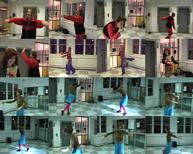 © Marianne Decoster-Taivalkoski
© Marianne Decoster-Taivalkoski
Aquatic is an enveloping, interactive water soundscape installation. The visitors are invited to participate in a multisensorial experience by exploring the soundscape through bodily movements within the empty space of the installation. They hear it as the accurate feedback of their movements.
Aquatic proposes an immersive and poetic experience of imaginary water worlds playing with kinaesthesia and sound images. It gives the main role to one's imagination in the building of the experience of immersion. It proposes a reflection about the influence of sounds on our sense of space and our imagination. How sounds, bodily movements and interaction arouse in us body memories and sensations.
The soundscape handles three emotional states free to one’s interpretation: soft and quiet waters, refreshing streaming waters and tempest waters.
The system uses David Rokeby’s softVNS software and Max MSP to generate a real time sound feedback to bodily movements registered with video sensors. Since its development in 2001-2003, Aquatic has been installed in various art museums and public places within the city of Helsinki since 2004.
Aquatic: Marianne Decoster-Taivalkoski
14
Jun
Wille Mäkelä, born 1954 in Helsinki, studied first oil painting in the Fine Arts Academy of Finland, starting 1976. However, he graduated as film director, 1987. After several years of film and theatre works, he started doctoral studies - in new media.
Wille Makela: Painted into air & Chemotaxis
14
Jun
 © Sanna Ikäläinen and Wille Mäkelä
© Sanna Ikäläinen and Wille Mäkelä
“Painted into air” is an immersive fine art exhibition, first presented in Kiasma, Helsinki, in 2005. Spectators can step in the stereo display of a two-screen corner and move among three-dimensional free hand traces, painted by Wille Mäkelä and ten guest artists.
At the astonishing new experience of painting into the air, each of the artists found a personal way to study the depth. Exploring the traces in immersion, spectators may now find a bridge between the new medium and traditional handwork.
Painted into Air: Wille Mäkelä
13
Jun
Animaatiokone Industries is a three person interaction design co-operative with main emphasis on image processing, computer vision and user interface design. Animaatiokone Indusries other projects include Animaatiokone Studio desktop software and award winning Kick Ass Kung Fu fighting game simulator.
Perttu Hämäläinen, Mikko Lindholm & Ari Nykänen: Animaatiokone
13
Jun
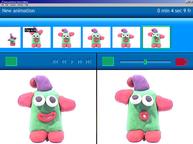 © Hämäläinen, Lindholm, Nykänen
© Hämäläinen, Lindholm, Nykänen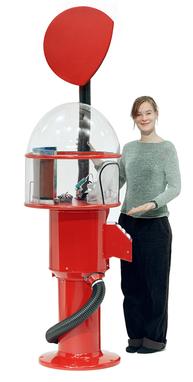 © Hämäläinen, Lindholm, Nykänen
© Hämäläinen, Lindholm, Nykänen
Animaatiokone is an easy-to-use, futuristic installation that turns you into a master animator. It is built on custom animation software and technology that make animating quicker and more fun than ever. All you need to start is a piece of plasticine.
Animaatiokone aims to teach people about animation and show how easy it can be to create stop-motion animation. Award winning Animaatiokone combines technological and user interface innovations into a novel collaborative storytelling tool. The transparent studio-dome and the overhead monitor allow public to watch the animator at work and learn from each other. The dome contains a miniature studio with a backdrop and a movable camera and set pieces. Animations are captured one after another, each animator continuing from where the previous one stopped. The results vary from absurdly twisting drama to a fragmented animation sketch-book and subliminal glimpses.
All animations are presented on the Animaatiokone web site. The web site features the contributions of more than thousand users, many of which first-timers.
Animaatiokone: Perttu Hämäläinen, Mikko Lindholm & Ari Nykänen
12
Jun
Conferences | posted by Wolfgang Bednarzek | at 17:00:00
Recommended Reading: “Mobile Interaction Design”
What more and more people are now demanding from their high-tech paraphernalia is that it be easy to use—a key aspect of “Simplicity.” Matt Jones and Gary Marsden have been dealing intensively with this issue and have documented their experiences in the book “Mobile Interaction Design.” In it, their focus is more on human needs, wishes and capabilities than on technological parameters and preconditions.
The book elaborates on the key factors that make for good interaction design in the field of mobile technology in a way that is enlightening, lucid and reader-friendly. Its case studies and “maneuver critiques” of current high-tech gear are easy to read and deliver effective tools for crafting the user-centered applications of tomorrow.
In the words of the authors: “This book is about shifting the mobile design perspective away from ‘smart’ phones, to people who are smart, creative, busy, or plain bored. Our aim is to help you to overcome the frustrations of the previous disappointing handheld ‘revolution’ by providing the billions of potential mobile users with future products and services that can change their (or even the) world.”
12
Jun
A piece of high-tech equipment like an mp3 player should ideally be able to get across what it’s designed to do and how to operate it just as simply as a wedge, a sledgehammer or a saw does. You have the device in front of you, consider its form, try it out and, after a couple of attempts at most, you have all of its features down pat.
Blanket statements like this can get designers, programmers and engineers really worked up. Their critique might well maintain that comparing a highly complex instrument that represents the culmination of thousands of technological advances that this civilization has brought forth—from gramophone cylinders and shellac discs to radio and all the way to fiberglass cables, the PC and digitization—with a simple wedge is pretty farfetched to say the least.
But even companies like Microsoft, Intel and Adobe are increasingly coming around to this way of thinking. What other explanation is there for the fact that their efforts to achieve design breakthroughs are concentrating on collaboration with ethnologists and anthropologists? After all, these are precisely the fields of social science that deal with mankind’s interaction with tools. Here, the focus is on intuition, which is controlled by a number of different cultural factors and which enables us, among other things, to swiftly grasp how a particular object can be employed.
“Design ethnography” is the techno-speak term that has been coined to describe these scholarly disciplines that have been stripped down to their practical essentials and placed in the service of information technology.
We can only hope that a holistic approach that takes human beings and their overall cultural settings into account doesn’t get lost in the shuffle here.
In any case, when you consider the fact that ethnographic teams have been developing guidelines and generating studies for major players in the IT industry for at least five years, the results that this has yielded to date appear to be pretty meager.
More info and interesting articles on this topic are available online in “gotoreport” at www.gotomedia.com.
11
Jun
Prix Ars Electronica | posted by Maria Hieslmayr | at 19:15:00
Lara Srivastava (CA) - Jury Member "Digital Communities"
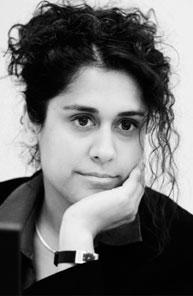 © Norbert Artner
© Norbert Artner
Lara Srivastava is ITU New Initiatives Programme Director with the Strategy and Policy Unit (SPU) of the International Telecommunication Union (ITU) in Geneva (Switzerland).
Ms. Srivastava has over 10 years of experience in the telecommunication industry. She is currently responsible for monitoring and analyzing trends in information and communication technology, policy, and market structure. She organizes and advises on workshops and symposia programmes, covering topics of interest to policy-makers, regulators and industry. In this context, she acts as Programme Director for ITU’s New Initiatives Programme (www.itu.int/ni), and contributes to programme development for the global ITU TELECOM Forum.
11
Jun
Prix Ars Electronica | posted by Maria Hieslmayr | at 13:15:00
Yukiko Shikata (JP) - Jury Member "Net Vision"
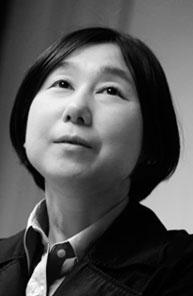 © Norbert Artner
© Norbert Artner
Yukiko Shikata is an independent media art curator & critic based in Tokyo, actively engaging in media art projects especially with social and public aspects including the "MobLab" as an initiator. She works as a curator of NTT InterCommunication Center, and specially-assigned professor at Tokyo Zokei University, guest professor at Tama Art University, Kyoto University of Art and Design, lecturer at Osaka Seikei University.
Her works include projects at Canon ARTLAB (co-curator, 1990-2001), Mori Art Museum (Associate Curator, 2002-04) Mischa Kuball "Power of Codes - Space for Speech" (Tokyo National Museum, 1999), "Kingdom of Piracy" (online, co-curated, 2001-), Rafael Lozano-Hemmer "Amodal Suspension" (Opening project of YCAM, 2003), "SonarSound Extra" (sonarsound Tokyo, 2004), "EnigmaAnagma the evening of Yukiko Shikata" (DEAF, 2004). She is a curatorial advisory board member of Transmediale (Berlin).
From: www.transmediale.de
11
Jun
Prix Ars Electronica | posted by Maria Hieslmayr | at 10:05:00
Wilhelm Burger (AT) - Jury Member "the next idea"
Wilhelm Burger is the director of Media Technology and Design at Hagenberg Polytechnic University. He studied computer science at the Johannes Kepler University in Linz, the University of Utah and the University of California at Riverside.
Before his appointment, he worked as a developer of visualization software for ultrasound equipment, and as a researcher and developer of vision-based navigation for autonomous land vehicles and as a university assistant in the field of image processing.
10
Jun
Prix Ars Electronica | posted by Cornelia Sulzbacher | at 11:15:00
Dietmar Offenhuber - Jury Member "Computer Animation / Visual Effects"
Dietmar Offenhuber graduated in architecture at the TU vienna. After first steps in digital media art with the group RELAIS (1995 with Schilcher, Palmetshofer), he considers having received his main education while working at the ars electronica futurelab, where he was a core team member from 1995 until 2004.
After graduation in 2002 Dietmar worked as a key researcher for interactive space at the lab, responsible for the development of exhibitions, interfaces and curatorial concepts.
In 2004 he received a Fellowship from the Japan Foundation for the IAMAS institute in the dept. of prof. Christa Sommerer. From 2004 to 2006 Dietmar Offenhuber served as professor for animation and interactive media at the University of Applied Sciences in Hagenberg.
(Since Fall 2006 he is researcher at the MIT medialab in the sociable media group of prof. Judith Donath.)
One of his main interests is investigating the spaces of the everyday by means of interactive mapping techniques. These endeavors result in videos, interactive installations and mapping projects. A recent collaboration in this area with composers Sam Auinger and Hannes Strobl has been established under the name “stadtmusik”.
Awards include a nomiations for the ZKM’s interantional media art award and for the FEIDAD award, honorable mentions at transmediale and ars electronica.
10
Jun
Prix Ars Electronica | posted by Cornelia Sulzbacher | at 09:15:00
Rob Young - Jury Member "Digital Musics"
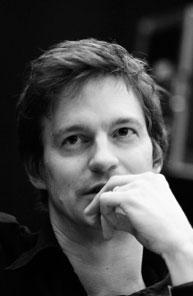 © Norbert Artner
© Norbert Artner
Rob Young is Editor-at-Large of The Wire magazine, and a writer and broadcaster who contributes to The Guardian, Uncut, Frieze and Resonance FM. He is the Editor of Undercurrents: The Hidden Wiring Of Modern Music (Continuum Books 2002) and is currently working on an illustrated 'biography' of Warp Records.
Blog Authors:
Maria Hieslmayr Cornelia Sulzbacher Wolfgang Bednarzek Gerda Hinterreiter Didi Offenhuber Beta Lounge Artists David Cuartielles Sonja Meller StWSt denCity.net
Search:
Categories:
Conferences Animation Festival Events, Concerts & Performances Campus Exhibitions e-lobby Prix Ars Electronica
Recent Posts:
Photographs of the 2006 Festival Media lab thanks! Ars Electronica Center FM4 Live from Ars Electronica in Linz
Archives:
Posts 180 - 160 Posts 160 - 140 Posts 140 - 120 Posts 120 - 100 Posts 100 - 80 Posts 80 - 60 Posts 60 - 40 Posts 40 - 20 Posts 20 - 0


